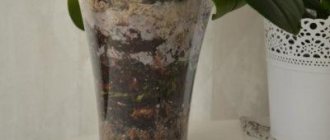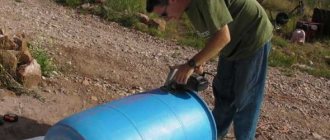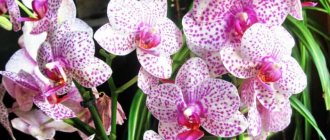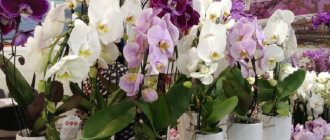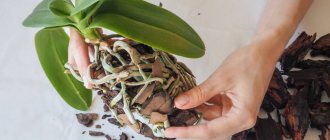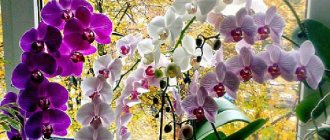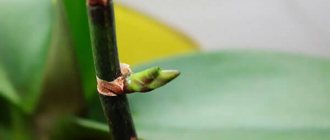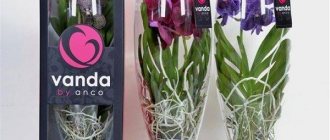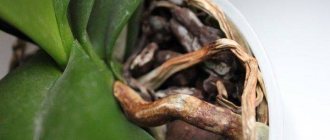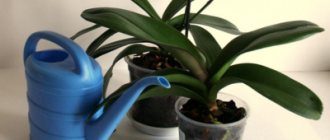There are a lot of ideas on how you can grow flowers at home, but glass orchid pots are one of the popular options. The method is new, but if you do not carefully study its features, you can make mistakes that will lead to the death of the plant.
An orchid without a substrate or in the ground should be only partially immersed in a flowerpot, which will allow it to remain outdoors. The sockets at the base should be placed flush with the edge of the container. Support is required, for which you can use wire.
Features of the technique
Most orchids are epiphytes that live in a “suspended” state. Clinging to the bark of trees with aerial roots, they receive moisture from the air or from streams of rainwater. They draw useful substances from dying layers and rotted leaves.
It is impossible to recreate a tropical climate in a residential area, but certain conditions can be brought closer to natural ones. At the same time, the presence of a substrate is not the most important thing when keeping an orchid. It is much more important to ensure uniform moisture, nutrition and air exchange of the roots.
There are many ways to cultivate - in bark, on blocks, hydroponically, and even with bare roots in a glass pot. The last option is not known to many, but it is very interesting, so it is worth paying special attention to it.
How to choose a glass vase
Wide, stable vessels of spherical and cylindrical shape are preferred for placing orchids. Vases in the shape of a cube or glass are suitable. You can use double planters, in which the inside contains holes for drainage.
Definitely won't fit:
- narrow, cylindrical or rectangular containers - the roots will be cramped in them;
- pots that are too high - the plant “sinks” in them along with the leaves and flower stalks.
Before buying a vase, imagine your orchid inside: is there enough space for roots and how will the leaves be arranged? Consider the possibility of securing the plant in a vertical position.
It is important to choose the most suitable place in the house. The plant should not be cooled under a window (it may rot) and should not be roasted in the sun (the greenhouse effect will ruin the roots).
What varieties are suitable
Among orchids, species that do not require a dry and cool dormant period or have massive roots are better suited for cultivation in vases.
The choice of variety depends on the planting method:
- Into the water - phalaenopsis and vanda.
- Expanded clay includes phalaenopsis, dendrobium, vanda, cattleya, oncidium, coelogina, phragmipedium.
- In perlite - orchids with thin roots - dendrobium, oncidium, cattleya.
- In large diatomite - vanda; in the middle - phalaenopsis, dendrobium, slippers.
How to choose a vessel for an orchid
A whimsical flower will not please its owner with abundant flowering and good health if it is planted in an unsuitable container. It is very important to consider the shape of the vessel, the material from which it is made, and the filling.
Flowerpot shape
You need to choose a transparent flowerpot for a capricious orchid based on some nuances. You should immediately abandon narrow rectangular flasks and cylinders. The roots are crowded there, and the growth of the orchid will slow down. You should also not buy a tall glass in which the plant will “drown” along with the leaves. The ground unit must remain free in the airspace.
Common and popular forms of container for orchids:
- laconic geometry: simple cube, low wide cylinder;
- roundness: perfect ball, hemisphere;
- glass shape: narrow at the top, wide at the bottom;
- two vessels in one: the inner one has drainage holes, but is smaller in size than the outer one and is suspended in it. The containers are connected by their upper edges.
For an orchid, a vessel in the shape of a cognac glass is perfect - a wide and convex main part, a narrow neck in which the top of the rosette will be fixed from wobbling.
Material
I want to frame a beautiful orchid in a beautiful flowerpot, and when choosing a material, glass immediately comes to mind - transparent, ringing, reflective. However, glass flowerpots do not always have drainage holes, and without them the plant will die from excess moisture and lack of ventilation. You can, of course, try to drill holes yourself, but doing this is quite difficult without the necessary skills and tools.
However, a glass vase for an orchid cannot be completely ruled out. The main thing is that it is not narrow and cramped. You can take a wide square or round one, put a thick layer of drainage on the bottom, and plant a flower on top. Arrange the lower leaves so that they rest on the edges. This will give the plant stability. But vases that are too wide are not entirely suitable for orchids - aesthetics are at the expense of practicality. Don't forget about the long peduncle. It will require a rod fixed in a flowerpot.
Information! Not all orchids have roots that participate in photosynthesis. Varieties Vanda and Phalaenopsis can grow safely in a glass flask.
Transparent plastic will replace glass. Its advantages:
- such vessels always have numerous ventilation holes. If there are not enough of them, it is easy to drill additional ones in soft material;
- the massive roots of the plant do not stick or grow to the plastic, but glide freely over it;
- the material accumulates heat well and transmits sunlight well;
- There is a wide selection of multi-colored plastic vessels on sale; you can create a beautiful composition from a flower and a flask.
Design
Transparent plastic orchid containers come in different shapes, sizes and colors. When choosing, it is advisable to strive for complete harmony between the orchid variety, flower color, and plant size. White flowers will be set off by a bright flowerpot in rich colors. For colored ones, it is better to take a monochromatic one that echoes the main color of the flowers, or simply transparent.
Many small flowers will balance a large pot, and one or two large inflorescences will balance a small flask.
Advantages and disadvantages
| pros | Minuses |
|
|
What is used instead of soil?
The orchid feels great even not in soil saturated with humus, but on the trunks, branches, and roots of some tree. The components necessary for the development of a flower are not obtained from the soil at all . The atmosphere remains the source of nutrition.
An orchid needs soil only so that it can somehow gain a foothold and stay in a certain area. So when choosing components to be used instead of soil, you need to take into account their permeability to moisture and air.
In most cases, the main component for a homemade soil mixture is tree bark. You can pick it with your own hands or purchase it at a specialized store. Most often, gardeners choose pine bark, although the bark of oak and conifers is excellent. To assemble it, you will have to use sawn logs or dead wood.
To ensure the safety of the plant and protect it from pests and bacteria, pieces of bark must be cleaned of softened areas and dried thoroughly .
In addition to bark, flower growers actively use sphagnum moss as soil. Its main purpose is to make the soil loose, retain moisture without compacting the soil, absorb harmful salts and have a bactericidal effect.
Tydea - growing and care at home, photos of species and varieties
We invite you to watch a video about the types of soil for growing orchids:
Growing methods
The plant needs to be allowed to get used to life without soil.
An orchid in a glass flowerpot can grow:
- in water (hydroponics);
- in mineral material immersed in water (semi-hydroculture);
- on blocks;
- in the substrate.
A substrate in a glass flask is not a good idea, because glass interferes with the ventilation of the roots, and the orchid may rot.
Let's consider options without using soil.
In water
Growing in clean water (hydroponics). In this case, the stem is fixed above the vase, and the root lobe is partially immersed in water.
It is better to accustom the plant to keeping it in water in spring or early summer.
The technology consists of planting an orchid on an inert material that does not decompose in water: expanded clay, perlite, zeolite, diatomite. Saturation with water occurs due to the capillary effect. Nutrition for the roots is supplied using fertilizer solutions.
Hydroculture Materials:
- Expanded clay fraction 8-14 mm (not construction!). The most common option. Before use, you need to rinse it, then soak it overnight.
- Perlite is a white mineral material that resembles foam. Gives a good capillary effect and has excellent breathability. Washed before planting.
- Diatomite is a sedimentary rock (little is known about it yet). Absorbs up to 150% of water. Soak for an hour.
- Green mix is a planting mixture made of mineral wool with the addition of perlite. Can be mixed with any listed materials.
On the blocks
An orchid block is an imitation of a tree support: a piece of pine bark or cork, driftwood, fern roots, a skein of coconut fiber. Blocks, as a rule, are fixed in greenhouses, greenhouses, or aquariums, as they require high air humidity.
For cultivation in flowerpots, choose mini-phalaenopsis, small species of dendrobium, oncidium, cattleya, and aerangis. The flask should be wide so that the entire plant with roots and leaves has room to grow.
Planting technology:
- A piece of bark or driftwood is washed, boiled and soaked in water for a day.
- The orchid is removed from the pot, the roots are wrapped in sphagnum moss or coconut fiber.
- Fix the roots to the block using fishing line or wire.
- The plant is soaked for half an hour in a container of water.
- The block is installed or hung on a hook inside the flowerpot.
Features of the development and growth of plants without soil
Vanda is a monopodial epiphyte , less often a lithophyte, and it feels great with bare roots without soil .
Usually it has a powerful system of aerial, velamen-covered, gray-green roots. In nature, it clings to them, holding onto a support. It should be understood that vandas are tropical plants and they live in a very humid climate, extracting moisture and nutrition from all parts of their body from precipitation and air.
In indoor conditions, the plant should recreate similar conditions. And if the flask takes care of the humid microclimate necessary for the aerial roots, then the gardener will have to feed the vanda a little more often than other orchids.
Basic principles of care
The main operations for caring for an orchid in a vase are watering, fertilizing, and preventing diseases. Labor costs for changing soil and replanting are reduced.
Flasks must be washed regularly
In order for the composition to have a decorative appearance, the flask must be washed to remove algae and salt deposits about once a month. Plants in hydroculture are removed once a year, the roots are inspected, and the salted layer of expanded clay (diatomaceous earth) is replaced.
Watering
Much attention is paid to the quality of water: ordinary water from the tap is clogged with metal salts; orchidists recommend using rainwater or purified by osmosis with the addition of up to 10% tap water.
At home, you can filter water through peat, which removes excess calcium and reduces excess pH.
Hydroculture irrigation technique:
- In expanded clay: sprayed from above, then watered with water and fertilizer.
- In perlite, diatomaceous earth, green mix: spray generously, then carefully pour over the inner wall of the vase.
Important: Once a month, the plant is irrigated with plenty of water to dissolve accumulated salts.
Technique for watering orchids on a block:
- Remove the block from the greenhouse once every 2 weeks;
- immerse for 10-15 minutes in warm water, during the growth period - with fertilizer;
- attach in place.
- if the flowerpot is open, spray the orchid daily.
in winter
In winter, watering and spraying in the flowerpot is reduced. The vase with the plant is protected from drafts and isolated from the cold windowsill with a wooden stand.
Phalaenopsis and vanda growing in expanded clay can be dried until the roots appear silvery. The roots are inspected for rotting.
For orchids resting for the season, the water in the vase is maintained at a level of up to 1 cm - it does not contain fertilizers, it is added in a thin stream along the inner wall of the pot.
Feeding
Fertilizers for orchids are added to irrigation water according to the instructions, without exceeding the dosage. Generally accepted norm:
- during the growth period - 1 ml per 1 liter of water;
- during the rest period - 0.5 ml per 1 liter.
When in doubt, it is better to pour the product in a lower concentration than indicated on the package.
Prevention of possible diseases
Prevention of orchid diseases consists of maintaining optimal conditions:
- moderate temperature 20-25°C, at night not lower than 18°C;
- diffused light;
- timely removal of rotten roots;
- if necessary, spraying against pests, treating with fungicide.
Pros and cons of keeping orchids in water
You can grow a healthy orchid at home without a substrate, in liquid. But this should not be water straight from the tap, but a nutrient mixture containing a full range of microelements.
This method of growing orchids is called hydroponics.
Advantages:
- no risk of plant infection by rot and parasites living in the substrate;
- there is no need to change the soil, replanting the orchid and thereby causing additional stress;
- there is no shortage of nutrients;
- the roots are always moistened, and the plant itself blooms healthy and profusely.
Transplant technology
It is necessary to free the roots from the bark
First you need to remove the plant from the pot. Shake the substrate off the roots and thoroughly wash off any remaining soil. Then cut off the rotten and dried roots and dry the roots.
Landing in water:
- The plant, cleared of substrate, is placed in water up to the root collar.
- After 1-2 days, the water is drained, leaving a layer 1-2 cm thick.
- After a week, you can add more, accustoming the crop to more water.
Attention! The roots are not completely immersed in water; most of them should be on top.
Planting in expanded clay:
- Fill the lower part of the vase with expanded clay (up to half is possible). The orchid itself will grow roots to the required depth.
- Spread the orchid roots.
- Cover with expanded clay up to the lower leaves.
- Secure the plant in a vase.
Planting in perlite:
- First, a layer of expanded clay is poured.
- Next, the orchid is placed and the roots are covered with perlite.
- Perlite is compacted by immersion in water. The plant is fixed.
- To prevent the material from floating, a layer of decorative stones is placed on top.
Planting in green mix and diatomite:
- Pour in expanded clay.
- Next is the material for the germinating root system.
- Install the orchid, cover the roots with hydroculture.
- Pour the mixture well to compact.
- Secure the orchid.
- You can put expanded clay or decorative stones on top.
Diatomite and green mix should always be moistened with water. Otherwise, they will draw moisture from the plants.
Tips and secrets of professionals
Since the orchid is difficult to care for, the advice of professional flower growers will be very helpful in solving emerging problems with the flower.
What to do if the root system is very weak
In the case of a weakened, damaged root system, the orchid is removed from the glass container, the defective roots are removed and for some time, to form a powerful, viable system, it is placed in a mini-greenhouse. To do this, a five-liter plastic bottle is cut transversely on three sides, a layer of wet substrate (bark, moss, expanded clay) is placed on the bottom, into which a plant with pre-cut peduncles is placed. The bottle is tightly closed, securing the structure with tape. From time to time the container is opened to ventilate and moisten the substrate. After time, the roots should get stronger and recover.
Ventilation and aeration of the plant
As mentioned above, ventilation of the root system is ensured by a sufficient volume of the flowerpot and periodic removal of the plant from the vessel for forced ventilation and drying of the roots. As for the flower as a whole, it is not recommended to expose it to sharp drafts, especially in winter, as this can lead to frostbite of the leaf plates (manifested in the form of dark spots). When ventilating the room, the plants must be moved to more comfortable conditions at this time.
Did you know? Cut orchid flowers or its peduncle “live” in a vase with water longer than all other flowers.
Disinfection of containers
This manipulation will minimize the development of rot, algae, and deposits of mineral salts. To do this, the plant is removed, and the vase itself is treated with a weakly concentrated solution of potassium permanganate or special fungicidal preparations, after which the dishes are washed with running water.
Of course, the orchid does not belong to the “typical” indoor flower, which traditionally grows in the ground. However, by following the recommendations of professional flower growers and adhering to agrotechnical techniques for keeping phalaenopsis and other types of orchids, you can decorate the surrounding space with exotic flowers.
Possible problems
- Diseases. A common problem when growing in water is root rot. To combat it, the plant is taken out, treated with fungicides and dried for 24 hours.
- Pests. If scale insects or mites appear, the entire plant can be bathed in Fitoverm solution and repeated after a week.
- Adaptation. Orchid roots get used to new conditions within 3-6 months. Sometimes some of the roots die off, the remaining ones adapt to being in water or concentrate above it.
Orchid in Water Without Soil
7. Orchids in glass! Phalaenopsis without bark/soil. We put the baby away. Removing old leaves, 2016
Phalaenopsis in a glass vase
Capacity requirements
To grow flowers, you need to choose glass pots for orchids. This procedure is important, since an incorrectly selected pot will negatively affect the growth and development of the pet. Caring for phalaenopsis at home is no different from placing it in regular soil, but you need to take into account important nuances.
- Type of flowerpot.
- The material from which it is made.
- Form.
- Location in the house.
The form can be of various types:
- Classic, elongated upward - looks beautiful.
- Cylindrical, resembling a glass with a flat bottom.
The last type is not the most ideal choice, because:
- it is large in size;
- The containers do not look very attractive;
- it is not practical due to its inappropriate decorativeness.
It is better to choose a glass vase in the shape of a cognac glass, which:
- large;
- spherical;
- flattened in height;
- can accommodate the entire root system so that it does not stick out;
- compact;
- decorative.
In such flowerpots, the flowers do not feel stuffy, and the roots are provided with an ideal humid microclimate.
Orchids in glass containers grow well, since the material transmits light well, but the main advantage is considered to be decorative. Maintenance requires maintenance, which is complicated by the lack of drainage in the bottom of the flask. This can lead to an excess of moisture, and this has a detrimental effect on the condition of the root system, which can lead to the death of the flower.
You can place a pot with a plant planted in soil in a glass container, adding decorative stones to the space inside the vessel.
Advantages:
- Attractive view.
- Large selection of decorative elements.
- The roots of the plant will receive a sufficient amount of nutrients and air.
- If necessary, you can remove the outer glass container.
Minuses:
- It is difficult to choose the shape of the outer pot.
- Air circulation may be disrupted, which will negatively affect its growth and development of stems.
- There may be excess moisture.
Types and varieties of Vanda
The Vanda orchid is easy to cross. Many hybrid varieties of Vanda have been bred, and breeders are not losing interest in this beauty. The most attractive species and many interspecific and intergeneric hybrids are grown in culture - variously colored, with beautiful leaves and large flowers. Let us introduce you to the most popular of them.
Blue (Coerulea)
This plant was found in 1837 in the foothills of the Eastern Himalayas at an altitude of 1500 m above sea level. The plant is tall, up to 1 m. It has a powerful, well-developed, hanging root system. The leaves are belt-shaped, dark green, shiny, with an oblique cut at the top. They reach 20 cm in length.
Peduncles are tall, straight, up to 50 cm in length. From 6 to 15 flowers up to 10 cm in diameter are formed on one peduncle. The petals are blue, dove-gray or lavender and covered in a delicate, net-like pattern in a darker shade. Over time, the color lightens and becomes pale blue. Flowering occurs in autumn, in October.
Tender (Suaris)
A very beautiful plant. The bright petals of large white flowers are strewn with purple dots. Flowering usually begins in spring, lasts a long time, and up to 12 buds bloom on one peduncle.
Sandera (Sanderiana)
The pride of the Filipinos, the Sander orchid is, unfortunately, quite rare in the wild. It is classified as a large Vanda species. It has a dense, well-developed root system and long, up to 40 cm in length, beautiful leaves with a forked tip. Peduncle straight, tall. It can accommodate up to 10 large flowers (about 15 cm in diameter) at once. The flowers have a soft pink color on the upper petals, and the lower petals are yellow-red. The lip is large, up to 15 cm, colored simultaneously in yellow and red shades.
This may be interesting: Types and varieties of Phalaenopsis orchids
Rothschildiana
Hybrid type of orchid. This is an epiphyte resulting from crossing Vanda Blue and Sander. Has all the distinctive features of its parents. Only the flowers differ in their large number (up to 20 of them on a peduncle) and smaller size (up to 5 cm in diameter). The color of the petals is blue. The lip is short and dark. The leaves are rough, with forked tips, like Sandera.
Valkovata (Vanda teres)
This is a very large epiphytic plant. In nature, its branched stem stretches to a height of up to 3 m. When kept indoors, the length of the stem is also decent - up to 2 m. The stem (climbing or lodging) has numerous aerial roots. The leaves of this Vanda are 20 cm long and only 3 mm wide. They are located on the stem in two rows.
From 3 to 6 large (7-10 cm in diameter) flowers are formed on the peduncle. The sepals and petals are ovoid or diamond-shaped and have wavy edges. The lip in the center is three-lobed. The lower blade is purple in color and divided in the middle. The side lobes are yellow and decorated with red splashes. Begins to bloom in autumn.
Javiera
A low specimen, up to 50 cm in height. It has dense rows of dark green leaves along the edges. The flowers are medium in size, there are up to 12 of them on a peduncle. Both the petals and the lip are snow-white.
Tricolor
This epiphyte is very tall and can grow up to one and a half to two meters in height. The leaves are elongated, belt-shaped, rough, up to 40 cm in length, arranged on the stem in two rows. Vanda got its name for the original shape and color of the flowers: brown spots are scattered across the white-cream field of petals. The central lobe of the lip is pink-violet. The wavy edges of the petals add special beauty. Blooms 2 times a year: May–June, October–January. Up to 10 flowers up to 7 cm in diameter can simultaneously fit on one peduncle. The flowers smell nice.
Norbert Alphonso
The plant is medium tall, about 90 cm in height. The flower stalks are medium. Each one has from 10 to 15 large flowers with pink petals. The lip is wrapped in an original burgundy tube.
Great
A large orchid native to the Maltese Islands. It has a thick stem with tough long leaves. The flowers are yellow-brown in color with a diameter of up to 5 cm. Flowering occurs in the summer and lasts for several months.
Chess (Tessellata)
The height of the plant is one and a half to two meters. The leaves are greenish, densely located along the entire length of the stem so that they hide it. Up to 12 large buds of beige or, more often, brownish color are formed on the peduncle. The lip is painted in bright purple tones. Flowering is accompanied by a pleasant aroma.
Comb (Cristata)
It has a strong aroma and original lip color.
Conditions of detention
Since this variety comes from hot latitudes, the maintenance conditions must be appropriate:
- the air temperature should be between 16-29 degrees; if the room is more than 30 degrees, the plant may die;
- humidity should be within 80% (this figure can be maintained by regularly spraying the plant);
- Vanda does not require any substrate ; its root system must be constantly open. As a last resort, you can use oak bark as in the case of Phalaenopsis;
- This plant is very light-loving , but it is worth limiting direct sunlight. It is especially important to maintain proper lighting in winter; in summer, the orchid can be placed on the balcony;
- When planting in the ground, water the plant, just like other varieties of orchids: as the substrate dries.
Vanda's root system can be left open.
Important! The temperature to maintain this flower should be the same throughout the year.
Vanda does not have periods of rest or active growth . Only during flowering can the growth of its leaves stop. Strong changes in temperature can provoke a lot of diseases for the flower. It is best to keep Vanda open (without adding soil).
Landing
Disinfect the glass container (douse it with boiling water) or sterilize it (like jars).
- Pour a thick layer of expanded clay onto the bottom of the container (you can use other drainage). Disinfect it in advance.
- Lay a layer of sphagnum moss (you can do without this step).
- We fill the rest of the space with substrate (purchased or prepared independently).
- Pour the contents of the container with warm, settled water for 30 minutes to saturate.
- Drain the water completely and plant a flower in the bark. The moss is moistened in water, squeezed out and distributed in a thin layer on the surface of the bark, leaving free space around the root collar.
Watch a video about planting an orchid in a glass pot:
Vanda orchid in glass. Vanda - an orchid of extraordinary beauty
The genus Vanda belongs to the orchid family and includes about 60 species. Among them there are lithophytic species, but for the most part they are epiphytic plants, which determines the specific appearance of the root system - vandas, despite their rather large size, grow clinging to tree trunks. The straight stem of this monopodial (with one growth point) flower can reach a height of one meter.
Many of its aerial roots are covered with a layer of velamen. These are dead cells that form porous, hygroscopic tissue and absorb moisture from the air.
Holding it with their spongy structure, they protect exposed roots from sunburn and create a water supply, helping the plant survive dry periods without loss. Depending on the climate in which a particular vanda grows, its leaves will be of different colors and degrees of density, more fleshy - in species well adapted to low humidity. Their shape also varies: belt-shaped, valval (cylindrical) and ovoid. Vanda differs from other types of orchids in having flower petals located in the same plane and the absence of pseudobulbs.
Peduncles are found both drooping and erect. The inflorescence is a raceme with several fairly large flowers 9–10 cm in diameter. There are fragrant species. The color of the petals can be very different: from blue-blue to red-orange.
You can often see a so-called network of darker veins. Under favorable conditions, flowering occurs several times a year and lasts up to three months.
